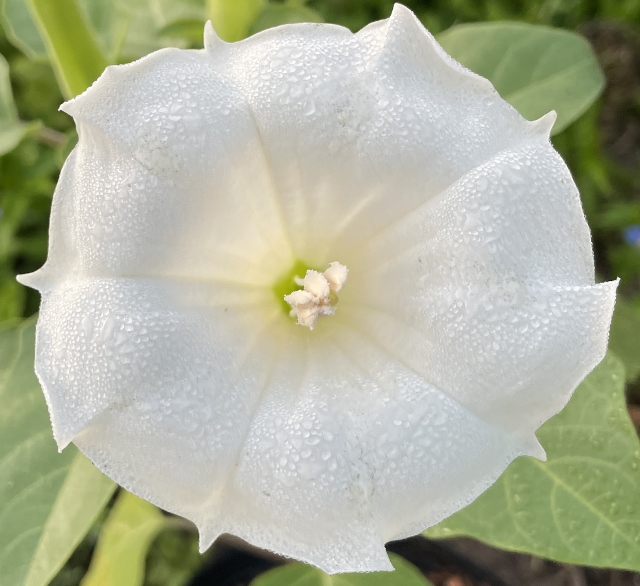On the exotic side, the nightshade family includes hundreds of species of showy and fragrant flowers; although still dangerously poisonous, they are not without their extraordinary beauty.
This post will wrap up a three-story series about native and cultivated plants in the nightshade family that can be found locally. There’s so much to learn about this family of plants; hopefully, I’ve whetted your interest. Previously, I discussed the dark, edible, wild and commercially lucrative nightshade plants, and now a bit about a couple of flamboyant nightshade species.
Previous posts: https://rgvctmn.org/blog/anitas-blog-nightshades-beneficially-questionable/ and https://rgvctmn.org/blog/anitas-blog-a-commercial-nightshade/
Recap: there are nearly 2,300 species of nightshade plants worldwide. They belong to the Solanacaea family of plants — most are toxic; the primary toxin is solanine.
Brugmansia is a beautiful, locally available cultivated woody tree in the nightshade family that goes by the common name of angel trumpet. It is native to tropical regions of South America, along the Andes from Venezuela to northern Chile and in south-eastern Brazil. The tree is in the Solanaceae family, Datureae tribe and Brugmansia genus.

Brugmansia species are amongst the most toxic of ornamental plants; they contain tropane alkaloids: scopolamine, hyoscyamine and atropine, such as are found in the deadly nightshade plant Atropa belladonna and other members of the Solanaceae family.
The seeds and leaves of the brugmansia species are especially dangerous, but all parts of the plant are poisonous.
The awesome, trumpet-shaped flowers are pendulous and can be as large as six to 20 inches long and four to 14 inches across at the opening. They range in shades of white, yellow, pink, orange, green or red. Most have a strong fragrance that is most noticeable in the evening. They attract pollinating moths.
There’s another plant in the Solanaceae family with the same common name of angel trumpet. It is native closer to home: southwestern United States and northwestern Mexico and east to Texas. Its botanical name is Datura wrightii and it’s often found in floodplains throughout Texas.
This angel trumpet is also known as sacred datura, southwestern thorn apple, devil’s trumpet, jimson weed and moonflower.

True to its nightshade classification, the large trumpet-shaped flowers open in the evening and close by midday the following day. The blooms are white, upward-facing, sometimes tinged with purple or violet at the rim and are quite fragrant and rich in nectar. They are pollinated by moths, typically sphinx and hummingbird moths — and perhaps by a freeloading fly such as was caught dancing on a filament in the above photo. The plant is a larval host for the Carolina sphinx moth. Species of bees, hummingbirds and hummingbird moths aid in pollination.

Datura wrightii can be grown in a pot, which will likely require daily watering in the heat of summer. The plant is self-supporting but sprawling; it can reach to six feet wide and five feet tall. A potted specimen can be pruned to keep it manageable. It is considered a perennial in our zone 10. It grows fairly quickly, likes full sun or partial shade, and has a long bloom period. Occasional watering is helpful for specimens planted in the ground.
Datura flowers were a favorite subject of the famous American painter, Georgia O’Keeffe, who lived in New Mexico for many years and painted huge portraits of desert flowers — she was once quoted as saying, “I decided that if I could paint that flower in a huge scale, you could not ignore its beauty.”
Datura wrightii easily propagates via seed; the pods are a pendulous, flat-topped ball about the size of a golf ball. They are pale green and covered in soft spines; pods turn brown when mature; when dry, the fruit splits open at the tip — be cautioned! One seed pod can produce 800 small, flat tan seeds!

The spiky, round pod gives the plant its common designation of thorn apple. The pods can be snipped off and dropped in the trash before they ripen in order to prevent a small forest of the plant.


The plant’s leaves release an unpleasant odor when bruised or crushed. The roots are large tuberous and very long and thick. All parts of the plant, from roots to seeds, are poisonous to humans if ingested; it is not known to cause contact dermatitis.
Again, common names alone can be confusing. Above, I mentioned that Datura wrightii also is commonly called jimson weed and moonflower, but be advised: plants named jimson weed and moonflower also are considered species of Datura stramonium — a different species of flowering plants in the nightshade family likely originating in Central America; Datura stramonium is considered an invasive weed in temperate climates across the world; it is not listed under invasive plants at www.texasinvasivies.org.

The flower of D. stramonium is nearly identical to that of D. wrightii; the seed pod, however, is egg-shaped instead of round and upright instead of dangling downward; the leaves are foul-smelling, alternate, and elliptical with dentate (toothed) margins and no hairs.
D. writghtii leaves feel rough; they alternate, are cordate (heart-shaped), ovate (flat, wider at base than at midpoint and tapering toward the tip) with undulating or wavy margins; they have fine hairs on the underside.
Nightshade plants typically have five flower petals that vary from the trumpet-shaped, like Datura and petunia, to a star-shape as in tomatoes and peppers. The male flower parts, the stamens, are usually fused to the flower petals or fused together to form a central cone that surrounds the female flower parts as in tomato. Trumpet-shaped flowers are usually pollinated by moths and star-shaped flowers by bees, according to information from the USDA’s, U.S. Forest Service.


Leave a Reply